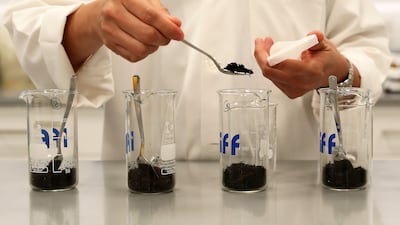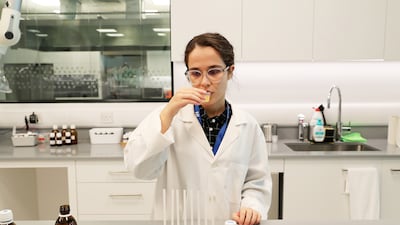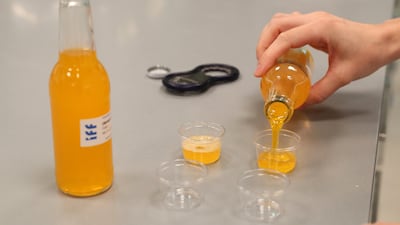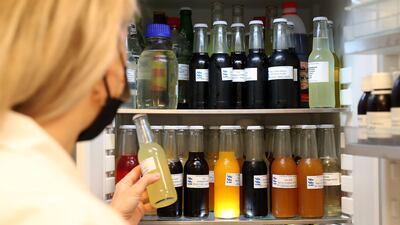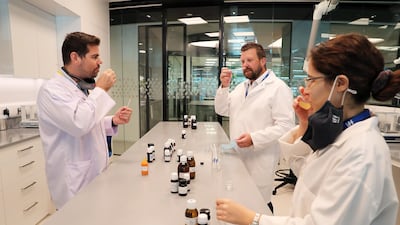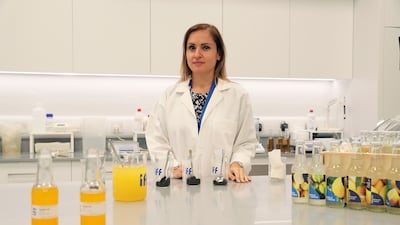At a laboratory in Dubai Science Park, taste experts are trying to crack the code for the perfect flavour of the Middle East.
They aim to convert some of the region's most popular food and drink into laboratory-made flavours.
It is then hoped manufacturers will use these in their beverages, confectionery and food.
The 1,400-square metre plant was launched last year by US corporation International Flavours and Fragrances (IFF).
Confidentiality is paramount but for one of the company's recent projects, farms and markets in the GCC were scoured for popular versions of oranges. The flavour created was then used to make a carbonated drink.
The National went inside the laboratory to see the flavour experts at work.
“Each region has its own particular tastes and preferences. For example, there are typical spices used in the Middle East that people want to have in their seasoning mixes or in their dishes,” said Sahar Razmkhah, technical manager at the lab.
“We are looking into the typical foods and beverages traditionally used in the region and see if those can be converted into flavours.”
The centre is run by a team of flavourists and compounders who can create up to 30 flavours a day.
They decide on the ingredients for everything – potato chips, snacks, carbonated beverages, juices, dairy, ice cream, bakery, chocolate and other food items. The flavourists have more than 15 years of experience in tasting.
“If you look at a market such as the GCC, people like their snacks a bit spicier and tangier. So, for example, a chilli lemon-type of taste is well preferred. But if you look at a market such as North Africa, or the Levant, we can say most people prefer milder tastes,” Ms Razmkhah said.
“For beverages, we find that people in the GCC have a sweet tooth.”
The laboratory is divided into various sections, such as one for cooking and tasting food items and another for mixing or seasoning.
The centre also has state-of-the-art equipment such as highly sensitive scales, carbonation machines and homogenisers. The instruments help in measuring the parameters necessary to create flavours and finished products.
Ms Razmkhah said the creation of a flavour was an elaborate process.
“Most of the time, we derive flavours based on what is already existing in nature. Let's say, for example, a strawberry flavour," she said.
"It might sound like one fruit but there are many varieties of strawberries: there are small strawberries, we have the sweet ones and more aromatic ones. They can be cooked in the form of a jam or a candy. So first of all, we need to define the kind of strawberry flavour we want to create.”
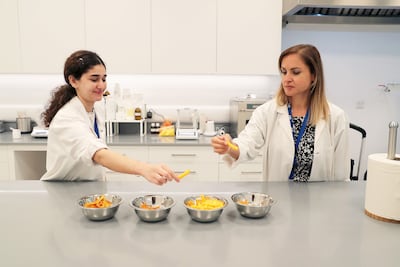
“After that we look at a variety of raw materials needed to compose the flavour. We have instruments that can analyse the fruit and we know scientifically what raw materials are required to reach different tonalities, such as for jams, sweets, candies and so on.”
Flavours are not used solely to bring a certain taste, they are also sometimes used to mask a taste or enhance elements such as sweetness or saltiness. As plant-based products gain popularity in the region, Ms Razmkhah said a good example is soy milk.
“People really don't like the strong taste of soy. So, some flavours help to suppress certain tastes so that other more pleasant tastes can be enhanced.”
Another example for the Middle East is mango, she said.
“People in Pakistan are used to a different taste of mango than those in Egypt. So we taste various types of fruits with different levels of ripeness," said Ms Razmkhah.
"Then we try to create flavours according to the local tastes. The samples of flavours are then presented to the manufacturers and they choose what works best for them.”


